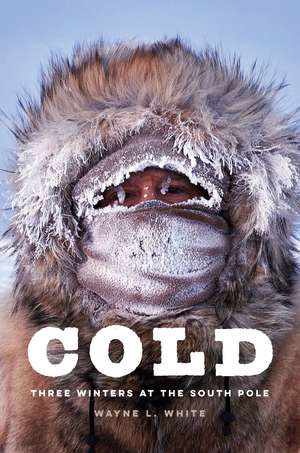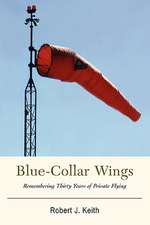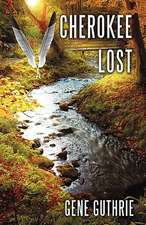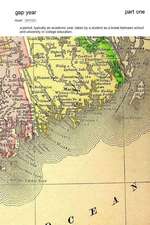Cold: Three Winters at the South Pole
Autor Wayne L. Whiteen Limba Engleză Hardback – 31 aug 2022
As the winter site manager of the Amundsen-Scott South Pole Station in Antarctica, White was responsible for the selection, training, and health and safety of the forty-two- and forty-six-person crews. Motivated by the determination and bravery of historical pioneers such as Roald Amundsen, Robert Falcon Scott, and Ernest Shackleton, White honed his leadership skills to guide a diverse group of experienced and talented craftsmen, scientists, and artisans through three winters, the longest term of any winter manager. Despite hardships, disasters, and watching helpless as a global pandemic unfolded far beyond their horizon, his crews prevailed.
In Cold White documents his time in these extreme elements and offers a unique perspective on the United States Antarctic Program at the South Pole.
Preț: 165.81 lei
Nou
Puncte Express: 249
Preț estimativ în valută:
31.74€ • 34.49$ • 26.68£
31.74€ • 34.49$ • 26.68£
Carte disponibilă
Livrare economică 01-15 aprilie
Preluare comenzi: 021 569.72.76
Specificații
ISBN-13: 9781640125520
ISBN-10: 1640125523
Pagini: 256
Ilustrații: 28 color photographs, 1 chart
Dimensiuni: 152 x 229 x 25 mm
Greutate: 0.52 kg
Editura: Potomac Books Inc
Colecția Potomac Books
Locul publicării:United States
ISBN-10: 1640125523
Pagini: 256
Ilustrații: 28 color photographs, 1 chart
Dimensiuni: 152 x 229 x 25 mm
Greutate: 0.52 kg
Editura: Potomac Books Inc
Colecția Potomac Books
Locul publicării:United States
Notă biografică
Wayne L. White is a veteran of the U.S. Marine Corps and has served as a civilian contractor in assignments around the globe for more than twenty-five years, with nearly three years in the U.S. Antarctic Program at the South Pole. He has conducted solo expeditions to New Guinea, the Amazon, and Africa. He is a member of the Explorers Club of New York City and the Adventurers Club of Los Angeles and received the 2020 Adventurer of the Year award from the Adventurers Club of Los Angeles.
Extras
The Glorious Ice
The Amundsen-Scott
South Pole Station is a ship. A ship with a
crew that sits atop nearly two miles of moving ice. The ship, the ice
that holds it, and its crew are on a voyage. A voyage that will take
several hundred thousand years before whatever is left of the ship
along with the ice that held it will arrive at its final destination, the
Southern Ocean. Its winter crew will change out annually and are
on a voyage of their own. That voyage will test some of them to
their limits, and all, to various degrees, will be forever changed by
the experience. While their icy voyage will not yield views of distant
lands, it will give some crewmembers remarkable insight into
unfamiliar places. Those places will include who they really are as
people and how their being impacts others. The crew will reside
in their ship in nearly complete physical isolation from the world
they knew. While inside, it will protect them from unearthly cold
that few on the planet will ever experience. They will lose the sun
and experience darkness that will last for nearly half the year they
are there. The ship and its crew will supply the light. I had the great
honor of being the captain of that ship for three Antarctic winters.
At the South Pole, at around minus 80 Fahrenheit, a strong exhalation
will result in a strange whooshing noise from a very visible
cloud coming from your mouth. At first, this noise surprises you
as you have breathed many thousands of times and never heard
anything like it. The sound’s origin is the fact that the water vapor
from your breath is freezing incredibly rapidly and hurtling through
the air. While out walking across the ice, you are startled by a loud
cracking noise that sounds as if things are collapsing and you will
fall into oblivion. The cause of the noise is a small horizontal void
of air collapsing within the ice. Much to your relief, you do not disappear
below the ice and walk on. When you are walking into the
wind and not wearing goggles, you start to develop icicles dangling
from your eyebrows and eyelashes. If you are out long enough,
these may need periodic removal as vision can be obscured. From
time to time, especially when facing into the wind, your eyelids
may temporarily freeze shut. Squinting hard, shutting your eyes
tighter will break the tiny ice seal, and much to your relief your
eyes can be opened. You can see again. I experienced those things
while at the South Pole and became used to them. I have heard of
another phenomenon that occurs when ice crystals are in the air in
a certain configuration. When this happens, it increases acoustics
to the point where you can hear normal conversations from long
distances. I never experienced that. Outside, I was always alone.
The ice and beauty of Antarctica did not call out to me. I never
liked the cold, but during my time at the South Pole, with much
exposure to unimaginable cold, I would eventually love it. I would
love it while still never liking it. Given any thought, cold is the
opposite of life. When things die, they cool. Life for humans is
about warmth, and it is abnormal to seek the cold. I learned to love
and to embrace the cold, but it took time and the ability to recognize
what it gave me. In the Midwest, where I grew up, there were
very distinct seasons, and I well remember after the muggy heat of
summer the euphoria of a chilly autumn with sweaters and jackets.
Then came the onset of winter and most years the wonders of
a white Christmas. After New Year’s, the novelty of the snow, ice,
and cold wore off and months of bleakness followed. Most birds,
other animals, and humans took refuge to await the spring, and
the white and icy world, to me, was cold and sterile.
Initially, my life took me to warmer places, starting with leav-
ing the Midwest for sunny California and the brutal experience of
usmc boot camp. I never returned to the Midwest and called California
home for several years before leaving for the warm tropical
climate of Diego Garcia British Indian Ocean Territory, where I
spent over five years living and working. This led to further foreign
overseas or U.S. remote site adventures and another fifteen years in
places such as Midway Atoll, Iraq, Kuwait, Wake Island, Afghanistan,
Saudi Arabia, and finally, Ascension Island South Atlantic.
The only anomaly in these mostly warm weather places where I
lived and worked was the nearly four years I spent on rugged Shemya
Island, Alaska, near the end of the Aleutian chain. While certainly
not tropical, Shemya did not have the frigid conditions of
Alaska’s interior. It was about as cold as I wanted it to be.
The Amundsen-Scott
South Pole Station is a ship. A ship with a
crew that sits atop nearly two miles of moving ice. The ship, the ice
that holds it, and its crew are on a voyage. A voyage that will take
several hundred thousand years before whatever is left of the ship
along with the ice that held it will arrive at its final destination, the
Southern Ocean. Its winter crew will change out annually and are
on a voyage of their own. That voyage will test some of them to
their limits, and all, to various degrees, will be forever changed by
the experience. While their icy voyage will not yield views of distant
lands, it will give some crewmembers remarkable insight into
unfamiliar places. Those places will include who they really are as
people and how their being impacts others. The crew will reside
in their ship in nearly complete physical isolation from the world
they knew. While inside, it will protect them from unearthly cold
that few on the planet will ever experience. They will lose the sun
and experience darkness that will last for nearly half the year they
are there. The ship and its crew will supply the light. I had the great
honor of being the captain of that ship for three Antarctic winters.
At the South Pole, at around minus 80 Fahrenheit, a strong exhalation
will result in a strange whooshing noise from a very visible
cloud coming from your mouth. At first, this noise surprises you
as you have breathed many thousands of times and never heard
anything like it. The sound’s origin is the fact that the water vapor
from your breath is freezing incredibly rapidly and hurtling through
the air. While out walking across the ice, you are startled by a loud
cracking noise that sounds as if things are collapsing and you will
fall into oblivion. The cause of the noise is a small horizontal void
of air collapsing within the ice. Much to your relief, you do not disappear
below the ice and walk on. When you are walking into the
wind and not wearing goggles, you start to develop icicles dangling
from your eyebrows and eyelashes. If you are out long enough,
these may need periodic removal as vision can be obscured. From
time to time, especially when facing into the wind, your eyelids
may temporarily freeze shut. Squinting hard, shutting your eyes
tighter will break the tiny ice seal, and much to your relief your
eyes can be opened. You can see again. I experienced those things
while at the South Pole and became used to them. I have heard of
another phenomenon that occurs when ice crystals are in the air in
a certain configuration. When this happens, it increases acoustics
to the point where you can hear normal conversations from long
distances. I never experienced that. Outside, I was always alone.
The ice and beauty of Antarctica did not call out to me. I never
liked the cold, but during my time at the South Pole, with much
exposure to unimaginable cold, I would eventually love it. I would
love it while still never liking it. Given any thought, cold is the
opposite of life. When things die, they cool. Life for humans is
about warmth, and it is abnormal to seek the cold. I learned to love
and to embrace the cold, but it took time and the ability to recognize
what it gave me. In the Midwest, where I grew up, there were
very distinct seasons, and I well remember after the muggy heat of
summer the euphoria of a chilly autumn with sweaters and jackets.
Then came the onset of winter and most years the wonders of
a white Christmas. After New Year’s, the novelty of the snow, ice,
and cold wore off and months of bleakness followed. Most birds,
other animals, and humans took refuge to await the spring, and
the white and icy world, to me, was cold and sterile.
Initially, my life took me to warmer places, starting with leav-
ing the Midwest for sunny California and the brutal experience of
usmc boot camp. I never returned to the Midwest and called California
home for several years before leaving for the warm tropical
climate of Diego Garcia British Indian Ocean Territory, where I
spent over five years living and working. This led to further foreign
overseas or U.S. remote site adventures and another fifteen years in
places such as Midway Atoll, Iraq, Kuwait, Wake Island, Afghanistan,
Saudi Arabia, and finally, Ascension Island South Atlantic.
The only anomaly in these mostly warm weather places where I
lived and worked was the nearly four years I spent on rugged Shemya
Island, Alaska, near the end of the Aleutian chain. While certainly
not tropical, Shemya did not have the frigid conditions of
Alaska’s interior. It was about as cold as I wanted it to be.
Cuprins
List of Illustrations
The Glorious Ice
Denver
The Crew
The Summers
The Winter Voyage
Food
Winter Traditions
Outside
Activities
Winter Issues
Crisis
The End of Winter
Duty, Honor, and Glory
The Glorious Ice
Denver
The Crew
The Summers
The Winter Voyage
Food
Winter Traditions
Outside
Activities
Winter Issues
Crisis
The End of Winter
Duty, Honor, and Glory
Recenzii
"An enlightening perspective on a remote region of the globe."—Kirkus Reviews
"This is just a fun and informative book to read. If Jack London had access to this book before he wrote To Build a Fire; his story might have been even better. "—Pennsylvania Literary Journal
“The ultimate checkbox for the world traveler’s bucket list is the South Pole. Several well-heeled tourists make it for the selfie, but to really experience the South Pole you need to overwinter and become a ‘polie’ to experience truest night and the deepest cold. Texan Wayne White has been there and done that.”—West Hansen, author of The Amazon from Source to Sea: The Farthest Journey down the World’s Longest River
“Eschewing normal desires for comfort and security, Wayne White undertakes extraordinary adventures, far off the beaten path, from which we learn much.”—Kevin Lee, member of the Explorers Club and the Adventurers Club
“Wayne White is one of the most interesting and accomplished adventurers I’ve ever met. This book is about an important chapter of his life when he served as the leader of the Amundsen-Scott South Pole Station for three (yes, three) winters. A must-read for anyone interested in Antarctica and the spirit of adventure.”—Jeff Holmes, past president of the Adventurers Club of Los Angeles
Descriere
Wayne L. White tells the story of his three winters as the winter manager at the Amundsen-Scott South Pole Station, the only winter manager in South Pole station history to last that long.























